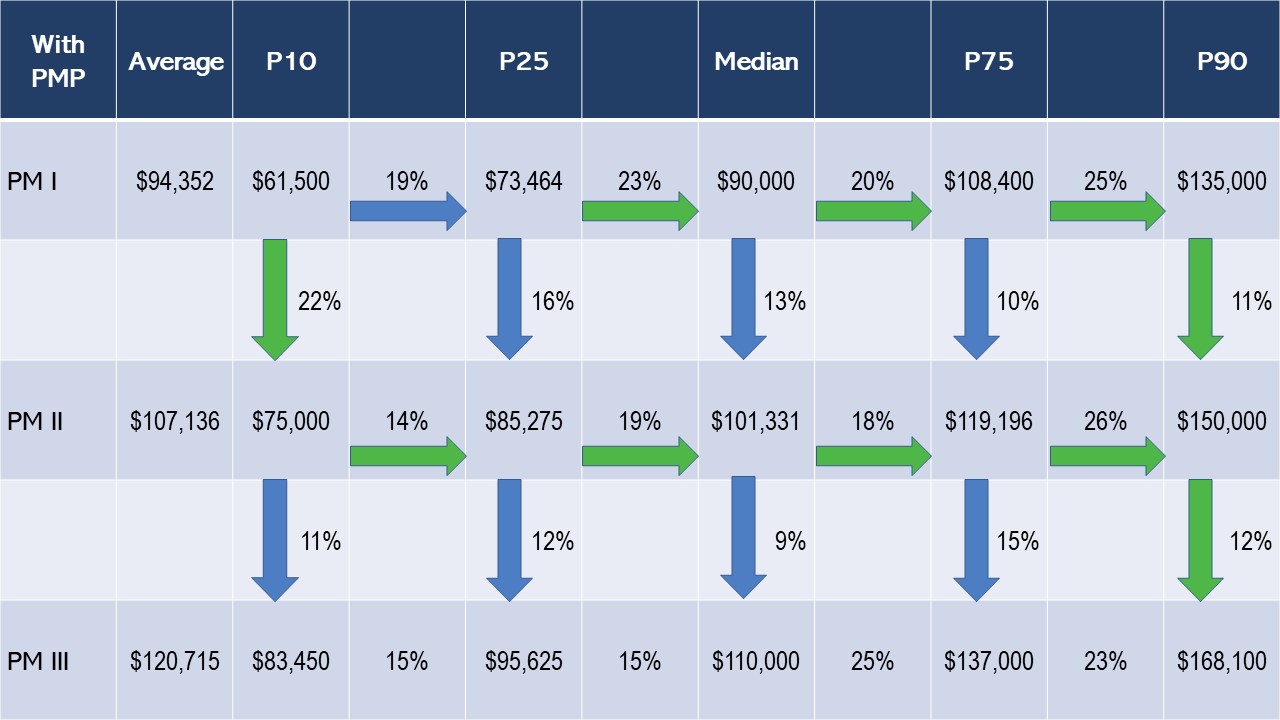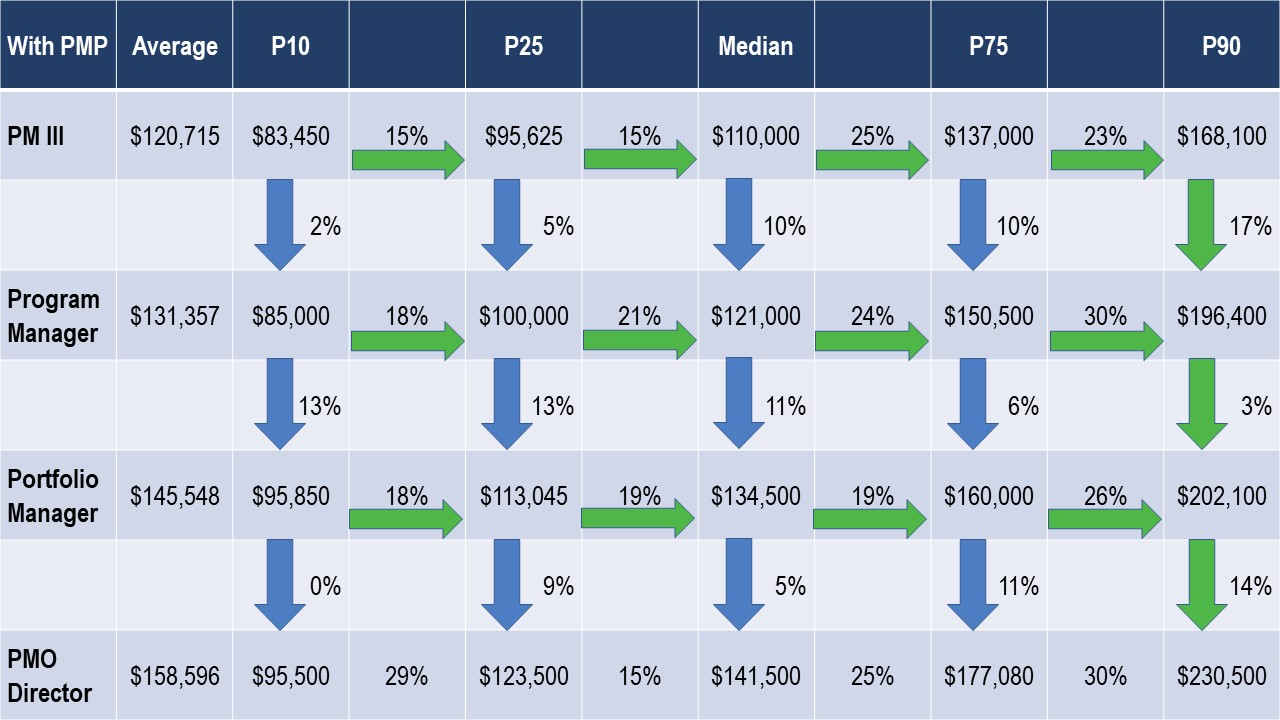
Guide, Trend and Analysis
Are you being paid what you are worth? In this guide, I will dive into project management salary numbers published by the Project Management Institute (PMI), provide some analysis and trend information. PMI categorizes Project Manager jobs into three levels. To find out which level you belong to, check out the job descriptions here:
Step 1: Identify what level of project manager you are based on your job responsibilities.
Even if your job title is Project Coordinator, based on your responsibilites, you could be categorized as Project Manager I by PMI standards.
Project Manager I
Under direct supervision of a more senior project manager, a Portfolio Manager, or a Program Manager, oversees a small project or phase(s) of a larger project. Responsibility for all aspects of the project over the entire project life (initiate, plan, execute, control, close). Must be familiar with system scope and project objectives, as well as the role and function of each team member, to effectively coordinate the activities of the team.
Project Manager II
Under general supervision of either a Portfolio Manager or a Program Manager, oversees multiple projects or one larger project. In addition to duties of Project Manager I, responsible for assembling project team, assigning individual responsibilities, identifying appropriate resources needed, and developing schedule to ensure timely completion of project. May communicate with a Senior Project Manager, Functional Area Manager, or Program Manager regarding status of specific projects.
Project Manager III
Under general direction of either a Portfolio Manager or in some cases a Program Manager, oversees high-priority projects, which often require considerable resources and high levels of functional integration. In addition to duties of a Project Manager II, takes projects from original concept through final implementation. Interfaces with all areas affected by the project including end users, distributors, and vendors. Ensures adherence to quality standards and reviews project deliverables. May communicate with a company executive regarding the status of specific projects.
Table 1: Project Manager - Average Canadian salary in Canadian Dollars. Lists total compensation i.e. salary and bonus.
| Source / Level | Year | Non-PMP | PMP | Value of PMP ($) | Value of PMP (%) |
|---|---|---|---|---|---|
| PMI - PM I | 2019 | $80,260 | $94,352 | $14,092 | 18% |
| PMI - PM II | 2019 | $95,114 | $107,136 | $12,022 | 13% |
| PMI - PM III | 2019 | $107,960 | $120,715 | $12,755 | 12% |
| Glassdoor | 2020 | $81,000 (salary only) | No breakdown between PMP and non-PMP | ||
| Indeed | 2020 | $80,060 (salary only) | No breakdown between PMP and non-PMP | ||
| Payscale | 2020 | $79,532 (salary and bonus) | No breakdown between PMP and non-PMP | ||
PMI conducts and publishes salary data every two years. For this first time in 2019, PMI published salaries for project managers with the Project Management Professional (PMP) credential and those without. Based on this data, having the Project Management Professional (PMP®) credential can boost your salary by $12,000 to $14,000 or 12% to 18%. The most significant jump is at the entry level.
As a comparison, Indeed lists the average 2020 salary for a project manager in Canada as $80,060. Glassdoor’s average salary is $81,000. The average salary listed at Payscale is $74,530 with a bonus of $5002 for a total compensation of $79,532. This is comparable to the total compensation of a non-PMP Project Manager Level I in 2019.
Career Tip #1: If you don’t have the PMP, aim to get it as soon as possible. Set a S.M.A.R.T. goal (specific, measurable, achievable, realistic, and time-bound) and ask your manager if the company will support you in this. These two articles provide a step-by-step guide on how to get your PMP.
- Abhijit Pandhari - Passed my PMP exam, you can do it too!
- Zia Ahmad - The resources & approach that helped me clear PMP in my 1st attempt!
Table 1b: Project Manager Salary in Toronto - Lists average total compensation in Canadian dollars i.e. salary and bonus.
| Source / Level | Year | Non-PMP | PMP | Value of PMP ($) | Value of PMP (%) |
|---|---|---|---|---|---|
| PMI - PM I | 2019 | $75,666 | $91,911 | $16,245 | 21% |
| PMI - PM II | 2019 | $102,118 | $105,606 | $3,488 | 3% |
| PMI - PM III | 2019 | $109,443 | $113,857 | $4,414 | 4% |
Analysis: This is shockingly true. The PMP boosts the pay of entry level project managers in Toronto by 21%. I double-checked the numbers reported by PMI. They are for Ontario as a whole. There were 52 non-PMP holders and 117 PMP holders at PM Level I. For experienced senior project managers, the PMP is not worth as much.
Career Tip: If you are an entry level junior project manager in Toronto and Ontario, get your Project Managemenet Professional certification as soon as possible.
Table 1b: Project Manager Salary in Vancouver - Lists average total compensation in Canadian dollars i.e. salary and bonus.
| Source / Level | Year | Non-PMP | PMP | Value of PMP ($) | Value of PMP (%) |
|---|---|---|---|---|---|
| PMI - PM I | 2019 | $84,112 | $89,396 | $5,284 | 6% |
| PMI - PM II | 2019 | N/A | $107,084 | N/A | N/A |
| PMI - PM III | 2019 | $107,202 | $128,507 | $21,305 | 20% |
Analysis: Vancouver numbers tell the exact opposite story compared to Toronto. It is the senior project managers who gain the most from a PMP: a 20% pay increase. Junior project managers only see a gain of 6%. There were fewer than 10 respondents in the Non-PMP PM II category so PMI did not report on it. What this tells me is that most junior PMs earn their PMPs before progressing to become intermediate PMs. The numbers are for British Columbia as a whole.
Career Tip: If you are a junior project manager in Vancouver, you don't need a PMP to get started but should look into getting it once you gain some experience and reach the PM II level. If you are a senior project manager in Vancouver and don't have the PMP, you are missing out on a significant pay increase: $21,000!
Table 2: Project Manager - Average Canadian compensation by Percentile in Canadian Dollars.

This table shows the average salary by 10th, 25th, 50th (median), 75th and 90th percentile. Horizontal arrows show the percentage salary increase when you move to another percentile. Vertical arrows show the percentage salary increase when you advance to the next level. You can either advance horizontally or vertically. The green arrow indicates a higher salary increase; the blue arrow indicates a lower salary increase.
Career Tip #2: Once you have your PMP, take a look at which percentile your salary falls in. From there, you have two options, get a raise while maintaining the same level and job responsibilities. For this you need to demonstrate that your skills and contributions have increased based on your years of experience. The second option is to move vertically up to the next level of responsibilities. Sometimes, moving horizontally will get you a better raise than moving vertically.
My general rule of thumb is this: if you are below the median, progress horizontally and once you are at the median or 75th percentile, aim to advance vertically to a role with more responsibilities.
In a coaching setting, I would give you personalized advice based on your values, strengths, areas of growth and long-term career roadmap. For example, if you are on a fast-track to be an executive, then you want to move vertically at every opportunity.
How do you advance horizontally or vertically? The PMI has introduced the talent triangle. To maintain your PMP, you need to maintain professional development units (PDUs) in Technical, Strategic and Leadership areas. While there are many offerings for technical skill development, career coaching can help you grow in leadership, business and soft skills needed to advance your career.
Table 3: Project Manager to PMO Director - Average Canadian compensation by Percentile in Canadian Dollars.

Analysis. What is surprising for program manager, portfolio manager and PMO director positions is that a promotion to the next level may not increase your salary as much as staying at your same level and adding to your skills, experience, and contribution. It is likely that 90th percentile salaries are only available in certain industries and may not be feasible for your specific industry. Pay more attention to median salaries because average salaries are calculated and may not actually exist in the real world.
Table 4: Project Management - Canadian Salary Trend 2003-2021
| Level | 2003 | 2005 | 2007 | 2009 | 2011 | 2013 | 2015 | 2017 | 2019 | 2021 Trend (Pre-COVID) |
|---|---|---|---|---|---|---|---|---|---|---|
| PM I | $71,788 | $75,886 | $84,145 | $85,050 | $86,514 | $90,838 | $80,104 | $91,143 | $94,352 | $97,875 |
| PM II | $82,168 | $79,933 | $91,105 | $96,776 | $98,159 | $101,765 | $96,425 | $98,297 | $104,865 | $108,268 |
| PM III | $89,330 | $98,407 | $112,539 | $109,223 | $113,082 | $115,902 | $115,922 | $117,434 | $118,536 | $122,961 |
Table 5: Project Management - Canadian Salary 2003-2021 Percentage Increase
| Level | 2005 | 2007 | 2009 | 2011 | 2013 | 2015 | 2017 | 2019 | Average Increase |
|---|---|---|---|---|---|---|---|---|---|
| PM I | 6% | 11% | 1% | 2% | 5% | -12% | 14% | 4% | 3.73% |
| PM II | -3% | 14% | 6% | 1% | 4% | -5% | 2% | 7% | 3.24% |
| PM III | 10% | 14% | -3% | 4% | 2% | 0% | 1% | 1% | 3.73% |
Analysis. What is worth noting is that the average compensation for PM III was below average from 2013 to 2019, and it was negative in 2009, likely due to the global financial crisis. What this tells me is that you probably do not want to remain a PM III for too long. Make a concerted effort to advance to a Program or Portfolio Manager.
Trend. From 2013 to 2019, the average biannual salary increase for all three project manager levels is 3.57%. The general trend is upward with the noticeable exception of 2015 when Canada was in recession due to a drop in the price of oil. Surprisingly, there was no impact to PM III salary. PM I salary took the hardest hit in 2015 but rebounded in 2017. If COVID-19 did not hit, the project total compensation for PM I, II and III would would range from $97,875 to $122,961.
| Level | 2003-2019 Average Increase | 2021 Trend (Pre-COVID) | 2021 Trend (Post-COVID) No Bonus | Projected 2021 Salary (Post-COVID) |
|---|---|---|---|---|
| PM I | 3.73% | $97,875 | -$3,818 | $89,379 |
| PM II | 3.24% | $108,268 | -$4,320 | $101,101 |
| PM III | 3.73% | $122,961 | -$6,217 | $112,265 |
While not necessarily reducing the salaries of PMs, COVID-19 may have reduced the overall number of jobs and there may not be a bonus for 2020. So my prediction is that 2021 salaries will likely remain at 2020 levels with no bonus. Bookmark this page and check back for an update next year.
Career Tip #3: To maintain your income with stagnating salaries and potentially no bonus, start making plans to get a promotion.
Sources
- Project Management Institute. https://www.periscopeiq.com/PMISAL/default.aspx
- Indeed. https://ca.indeed.com/salaries/project-manager-Salaries
- Glassdoor. https://www.glassdoor.ca/Salaries/canada-project-manager-salary-SRCH_IL.0,6_IN3_KO7,22.htm
- Payscale. https://www.payscale.com/research/CA/Job=Project_Manager%2C_(Unspecified_Type_%2F_General)/Salary
- Global News. https://globalnews.ca/news/7200264/canada-coronavirus-covid-19-pay-cut-wages/
- Global News. https://globalnews.ca/news/7090216/coroanvirus-salary-changes/
- Washington Post. https://www.washingtonpost.com/business/2020/07/01/pay-cut-economy-coronavirus/